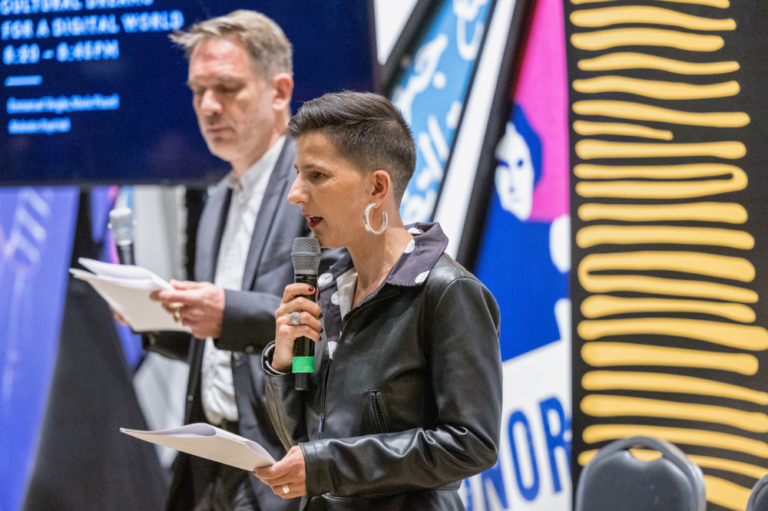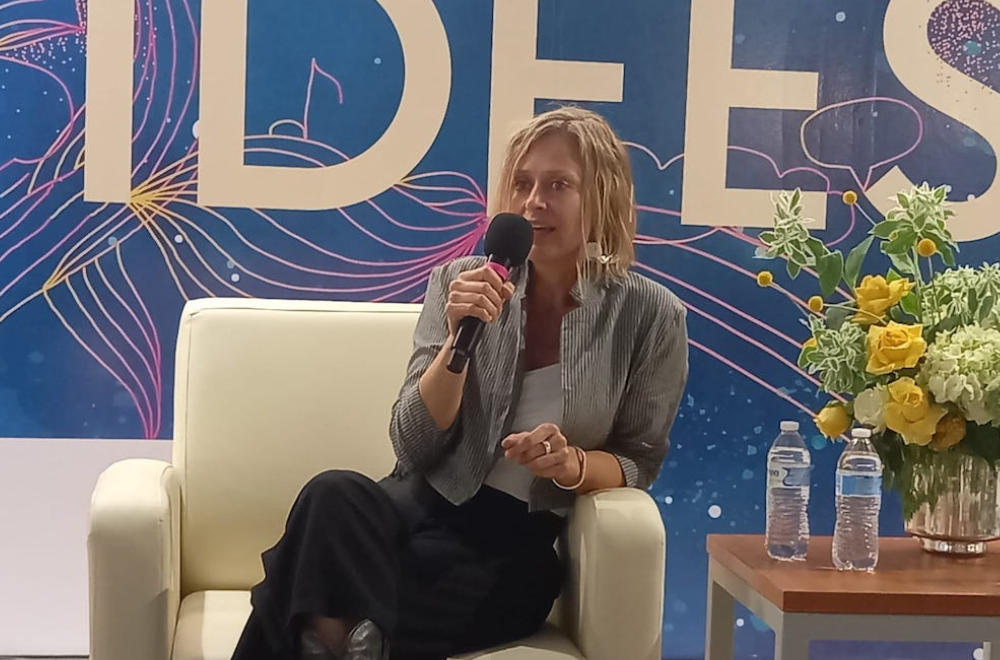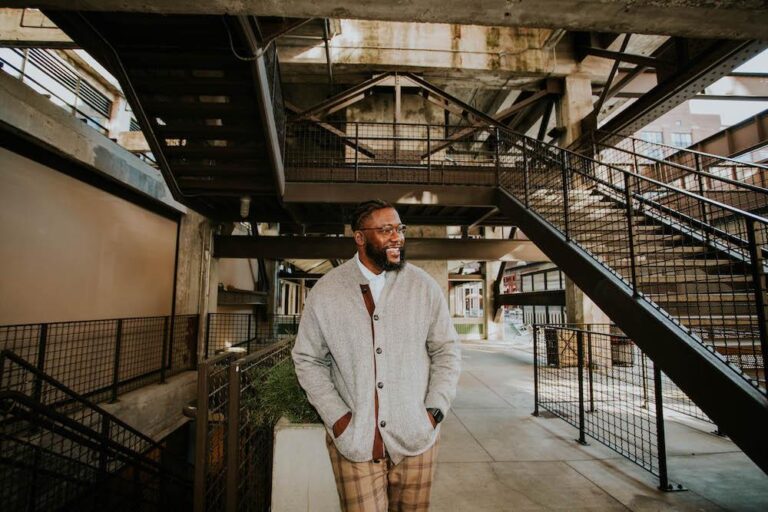
“Doing more with less,” or the art of being resilient

Ophélia Mantz during Night of Ideas in Monterey – © Amandine Castillo
By Ophélia Mantz
The term resilience, originally defined as the ability of a material to bounce back, has evolved through its use by various disciplines, including ecology and economics. Yet measuring a city’s resilience remains elusive. In this article, echoing her intervention at the Night of Ideas in Monterrey, architect Ophélia Mantz proposes to consider the notion of civitas and adaptation as a more precise term that reflects the progressive change of the urban system in response to crises. The concepts of ecosophy and temporal ecology are also mobilized in the quest to modify our lifestyles, to build a convivial society based on well-being and quality of life.
Etymologically, the word “resilience” – from the Latin words resilio, resilire – evokes the action of springing backward. This concept originally referred to a material’s physical capacity to return to its initial state following a sudden impact or constant application of pressure. But the meaning of the term has evolved considerably; it now possesses many different occurrences in its current usage linked to the various disciplines that have embraced it.
Its modern evolution can be traced back to physicist Georges Charpy’s use of the term “resilient system” in 1901, again denoting a material’s ability to spring back. But it also highlighted the impact of the external environment on the behavior of materials, going beyond their strictly internal properties. Rather than describing the resilience capacity of a single object, Charpy referred to the resilience capacity of a set of objects within a system.
Understood as the consequence of internal and external actions, this concept of resilience potential was later reinforced by the natural and social sciences. This in turn sparked a broad scope of interactions and led to “resilient” being used as a descriptor for systems or social groups (with terms such as “resilient system” and “community resilience”). In this context, we might speak of opportunities to be mobilized, whereby the resilience potential is based on the relationships that occur between subjects and their environment.
This same logic applies to the field of economics, which focuses on the way internal and external factors act upon an economic structure’s ability to return to a balanced state. However, the economic sciences incorporate another characteristic when defining a system’s resistant value–namely, the important dimension of time with regard to the restoration of balance. Other fields, such as IT, use the term “system resilience” to describe a system’s value according to its capacity to withstand faults or anomalies. But it is ultimately the research carried out in the field of ecology that has shaped the current notion of resilience, being directly related to the ways in which a system evolves, adapts, and reorganizes itself in the wake of particular impacts.
Indeed, the notion of resilience has undergone a long process of change and gradual fine-tuning, right through to its appropriation in ecological discourse, but it is not spared from certain conceptual limits when applied to the urban sphere. This is because ecology measures an ecosystem’s resilience by its capacity to bounce back from disturbances without altering the intrinsic quality of its structure. When the opposite occurs, we speak of “ecosystem bifurcation,” considering that there is one possible state of equilibrium from which the system in question deviates to a varying extent. This approach does not apply easily to the system of the city, which is built inherently on changing economic, social, and political systems. There is no single state of equilibrium for a city, as this would mean that the system is incapable of evolving, learning from crises, or reorganizing itself.
Given this great difficulty in measuring the resilience of an urban system, I propose that we look instead at the notion of civitas. This is a system that invites us all at once to consider the interactions of ever-shifting economic, political, and social spheres; and to speak instead of adaptation, a more precise term that reflects the gradual change of the urban system as a response to the crises that sustain it.
Adaptation is a process that helps us respond to crises that we have already experienced. But how can we tackle the various crises that threaten us now, such as the climate and social crises of dwindling material resources, and the pollution of our soil, air, and water? How should we ready ourselves in facing the unprecedented scale of these crises? An answer to these questions can no doubt be found in the writings of Ivan Illich. As early as the 1970s, this staunch defender of a convivial society was already suggesting that we “do more with less,” implicitly alluding to the art of being or becoming resilient.
The Night of Ideas has chosen the title MORE? for its 2023 edition, which aims to answer its own question through Illich’s notion of doing more with less, by addressing the two significant notions of ecosophy and temporal ecology. Far removed from a “techno-solutionist” approach, these two concepts allow us to rethink our relationships with ourselves, others, and our surroundings. But this ambition also demands a profound interrogation of the ideological foundations underpinning our societies (and traditional politics), which have linked the concept of freedom with that of affluence since the dawn of the modern era, as demonstrated by the French philosopher Pierre Charbonnier. Perhaps we should take inspiration from this disciple of Bruno Latour, and aspire to satiate our spirits in order to combat what we might describe as our bulimic desire for affluence.
Ecosophy is a portmanteau of the words “ecology” and “philosophy”, first coined by Arne Næss in 1972 and popularized upon his founding of the Deep Ecology movement. The philosopher proposed that we call into question the dominant place that humankind has seized over all other living species, and he advocated for greater respect toward our relationships with nature. Going a step further, he emphasized the value of natural living beings, which he ranked as more important than cultural values.
Næss’ neologism was later repurposed by the French philosopher and psychoanalyst Félix Guattari in his book The Three Ecologies, first published in 1990, taking on a radically different meaning. Næss embraced a dualistic approach that pitted nature and nurture against each other, whereas Guattari rejected this dichotomy and focused on the interconnection of the two. He sought to examine the interactions between what he defined as the three scales governing our relationships with the “natural” setting: psyche, socius, and environment. The ecosophical approach, as enunciated by Guattari in this book, still appears today as a valuable tool for thinking about ecology. However, it seems important to simply return to the value of the elements that participate in the construction of individual well-being. This could be measured on the basis of the notions of autonomy, pleasure and sharing, inseparable of course from the interactions established within a collective.
But how can we foster these values in our daily lives that have been weakened by social desiccation in the digital age, particularly with the emergence of Homo numericus? The answer may be to legitimize shared spaces that seek to impart these values. If this hypothesis were to be put into practice, such spaces would become settings for promoting a presence-oriented pedagogy based on learning through contact with others; through gardening, crafting, and sharing; and through autonomy, emancipation, and fulfillment. In this way, the shared spaces would develop “ecological niches” (per Jean-Pierre Warnier) that could spawn new values and behaviors.
As we continue to live with the trauma of COVID-19, we now find ourselves facing a certain schizophrenia regarding the value of collective spaces, simultaneously yearning for them and fearing them. Thankfully, there appears to be a persistent interest in promoting “physical” shared spaces—which long predates the pandemic—from community gardens to shared DIY spaces, co-development workshops, fab labs, and repair cafes. Whether taking the form of a shared space within a residential setting, or a collective space set up in a building or neighborhood, these spots are, by nature, moderately sized collectives that drive convivial relationships.
Many entities involved in cities or civitas seem to be aware of the need to strengthen these spaces for sharing values, practices, tools, technical instruments, and actions involving materials (such as processing waste or reusing obsolete items) in order to access individual and collective well-being. These shared spaces can therefore be considered as the breeding ground for developing well-being in the individuation process. Eventually, they will be able to foster participation within a collective, helping to legitimize action and space for “making society”.
While ecology is based on the understanding of the interrelations between the system’s components, ecosophy also seeks at its core to study the system’s processes and, by extension, the rhythms and temporalities that govern them. This is what is posited by the chronobiological concept of temporal ecology, which seeks to analyze and understand the rhythms of living beings. Following on from the work of American sociologist and city planner Richard Sennett, this temporal ecology concept could prove valuable in offering new perspectives on the interrelations of the economic, social, and political spheres that comprise the civitas.
In this respect, we might refer to the final research report of the Moderato project published in 2014 by the French Ministry for Ecology, Sustainable Development, Transport, and Housing (which can be read here). This report reflects on, and promotes, a reappropriation of time through practices of decelerating individual and collective rhythms that govern behaviors and uses in urban settings. In other words, it lauds the concept of temporal ecology, which would allow us to envision a better quality of life for society, while preparing it to develop the art of being resilient.
Rhythms act upon our surroundings and, therefore, on our behavior. More specifically, urban spaces are able to reinforce individual and collective synchronization in order to mitigate the time wasted on asphalt or concrete surfaces. Parks, squares, community gardens, collective workshops, streets, and multi-purpose spaces are all effective media for restoring biological and social rhythms. These should be prioritized in the policies of cities that wish to strengthen resilience through, for example, promoting the slow transport methods of walking and cycling, which are themselves a form of resistance against the accelerated rhythms of daily life.
This brief introduction to ecosophy and temporal ecology demonstrates how these tools for reflection can help us modify our contemporary lifestyles. Above all else, the resilience of an urban system relies on economic, social, and political entities learning to adapt in the long term to the crises currently poised to strike them. Likewise, these entities must not shy away from advocating a fairer society whenever and wherever they can. It is high time we got to work to organize a more convivial society based on well-being and quality of life, both of which are generated through autonomy, pleasure, and sharing among individuals in shared spaces. Only then will we be able to take on the challenge posed to us by Ivan Illich: “Doing more with less.”
Ophélia Mantz is architect DPLG, and has a Master in Bioclimatic Architecture and Sustainability from Escuela Técnica Superior de Arquitectura de Madrid, Spain, 2015. Her line of research focuses on the construction of ecological thinking in the field of architecture and the city. Together with Rafael Beneytez, she is co-principal at Z4A/Z4Z4 architects‘ practice. She has received the ACSA Faculty Design Award 2019, the S.ARC H 2018, and the Spanish National Award of Public Parks and Gardens 2015, among others. Currently, she is Assistant Professor and Director of the Material Research Collaborative at the G.D. Hines College of Architecture and Design at the University of Houston, Texas, U.S.A.
During the Night of ideas in Monterrey on March 2nd 2023, she has participated to the Roundtable #1: “Me, My Environment and Others”.


